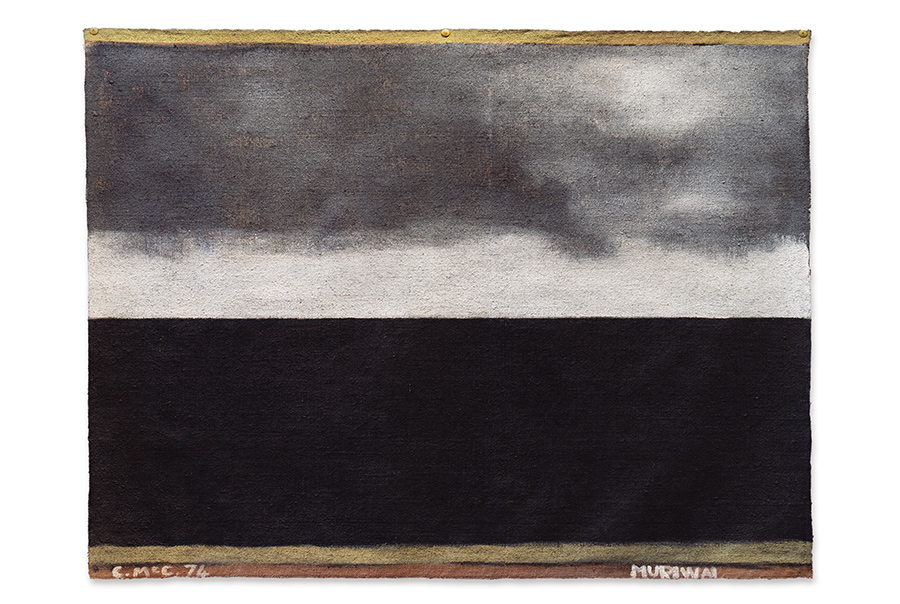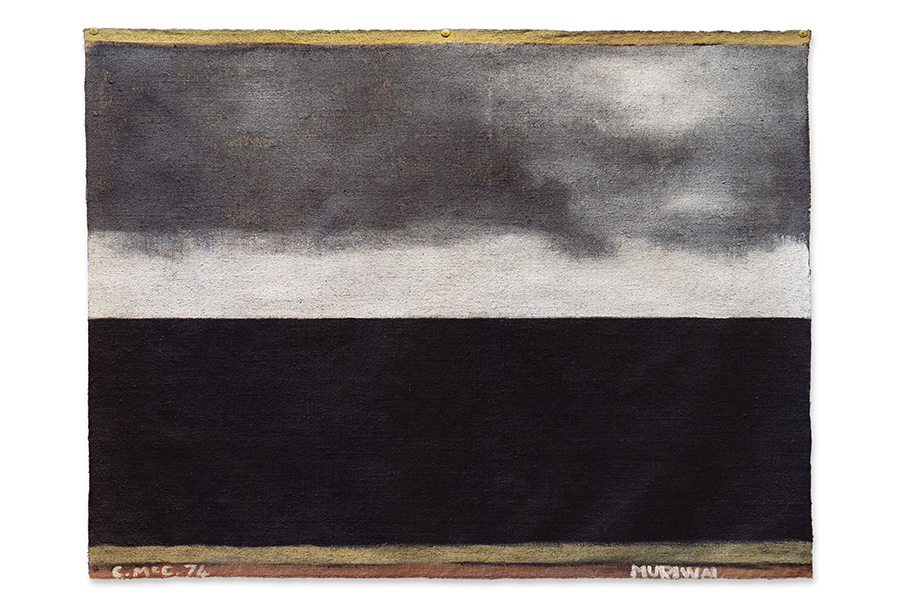
CULTURE

Muriwai, acrylic on unstretched canvas, 937 x 1048 mm, 1974 (Private Collection)
I Can Never Express My Angels
For the first time, the life of New Zealand’s greatest painter, Colin McCahon, has beenrevealed in his own words. DAVID HERKT interviews Peter Simpson, who explains just why this matters.
According to his friend, Ron O’Reilly, Colin McCahon, his wife, Anne, and their three small children were forced to leave their rented Tāhunanui house, near Nelson, in May 1948, after the landlord discovered he was an artist.
Writing to O’Reilly the same year, McCahon quotes a different real-estate agent saying to him — even when dressed in a shirt and tie — “No, I can see from the look of you, you’d be one who would not keep up the payments.”
In the immediate post-war world, these were the prejudices which faced the man who eventually became Aotearoa New Zealand’s single globally-regarded artist, whose paintings now gain multi-million-dollar prices at auction.
Edited by Peter Simpson, Dear Colin, Dear Ron: The selected letters of Colin McCahon and Ron O’Reilly is an intimate account of the thoughts and hopes of two men — a frank discussion of art, national culture, and the sometimes-dramatic events of their friendship.
McCahon’s public career and personal life could often be troubled. O’Reilly’s private world was tumultuous with three marriages. He would become the chief librarian of Christchurch City and eventually director of New Plymouth’s Govett-Brewster Gallery.
“Why publish an artist’s letters?” asks Simpson. “Well, because if you look at the letters of Cezanne and those of van Gogh, these letters are our own equivalent to those vitally important documents.”
Dear Colin, Dear Ron is also the first lengthy glimpse of McCahon in his own words. There has been no full biography. To read the book is to grapple with the life of New Zealand’s most enigmatic painter.
Simpson has become the indispensable McCahon expert, following his recent Colin McCahon, a lavishly-illustrated two-volume account of the painter’s work and career. After the 2016 publication of Bloomsbury South, Simpson has also continued to work on ‘The Group’ artists of mid-Twentieth-Century Christchurch: McCahon himself, Doris Lusk, Rita Angus, Toss Woolaston, Philip Clairmont, and Tony Fomison.
“There so much to say about an artist like McCahon that as a writer you never run dry; there’s always more to be said,” Simpson observes. “Partly this is because of his own eclecticism, a whole art universe is bound up in one career. Landscape one day; abstraction, the day after, Māori text the next; this year Bellini, next year Mondrian — endless fertility of invention, and yet it all hangs together.”
Dear Colin, Dear Ron gives its reader the equivalent of an all-access password to a modern-day email account. McCahon and O’Reilly were major confidantes over a period of 38 years, sharing their lives, careers, hopes, ambitions, and failures in frequent exchanges of letters. Exhibitions were organised. Works analysed. As men, they changed.
“I think it mattered initially that O’Reilly was older — by four years — and more settled in his life and opinions,” says Simpson. “Colin looked up to him and trusted him. As a trained philosopher he was a perfect interlocutor for Colin; initially an atheist Marxist pitted against an unorthodox Christian believer, though it soon evolved from that, largely from their mutual passion for painting. “
While O’Reilly admired McCahon’s work immensely, he was not afraid to argue. Sometimes he offered daring and frank appraisals, which were greeted with searching responses. The men discussed canvases which have now become essential to the story of New Zealand art: their origin, aim, execution, and ultimate fate, which sometimes included destruction.
“Ron was a dogged sort of character. He liked to get things straight. He liked to know the answer. He was endlessly curious. It drove Colin mad that he was so persistent… but because he trusted Ron so much, he takes the time to answer’s Ron’s questions to the best of his ability. Without Ron’s curiosity at the other end, many of those statements would never have been elicited.”
“O’Reilly was also an organiser; Colin’s work offered him endless opportunities for collection, promotion, persuasion, exhibition, defence. It got more complicated from around 1970 as McCahon began to resent O’Reilly’s tendency to be a ‘village explainer’ — as the writer Gertrude Stein once described the poet Ezra Pound: “good if you’re a village, but if you’re not, not.””
“Partly the trouble was that Colin got more irritable and fractious as alcohol got a stronger hold on him and his health began to fail. But Ron was patient and considerate. He put up with a lot, but he was also aware that his own behaviour could be less than perfect. They wrangled more often, but never lost basic respect, affection and mutual need.”
“Colin badly needed admirers and supporters, people who understood what he was on about but who offered resistance as well as support, rather than bland assurances.”
Dear Colin, Dear Ron also contains many fine descriptions of the cumulative grandeur of its New Zealand’s bush-denuded hills, stripped by human activity to their bare bones.
“I have read somewhere very recently of the monotony of the N.Z landscape…” McCahon wrote to O’Reilly, “but it is the same monotony that people first listening to Bach feel — a monotonous music but one when you listen with such form & order & lovely variations it isn’t really monotonous at all [,] and is not one landscape but this one and a continuation of it.”
“Have been up north,” he wrote much later in June 1970. “Ninety Mile where the flax blew inside out and was white, lead, silver, sand blowing for miles — a wind as I’ve never felt…” Ahipara soon featured in his drawings and canvases.
After some years living amid the kauri trees of Titirangi, McCahon began using a studio on Auckland’s West Coast. The various Walk paintings extended his vision along the bird-tracked and foam-streaked iron sands. At Muriwai, black scribbled chrysanthemums bloomed and burst in the sky above the sea. Moby Dick would surface like the offshore Oahia Island.
“You have both a radical simplification of imagery, but a huge elaboration of meaning, whether it is light pouring into a dark landscape, or the Cross…” says Simpson, suggesting that McCahon’s late paintings can be read as landforms, abstractions, significations or signs, or ultimately as symbols, “There are all those levels… and that seems to me to be what constitutes the major development of Colin’s painting as he advances.”
Dear Colin, Dear Ron swiftly becomes a virtual diary of two men as they created the groundwork upon which contemporary New Zealand painting and culture is based. Well-illustrated and annotated, the book not only foregrounds McCahon, his life and works, but O’Reilly’s role as an essential part of that artistic achievement.
“They were lucky to find each other and held on tight,” says Simpson. “On the whole it was a balanced partnership: admiration, respect, need and love on both sides.
Dear Colin, Dear Ron: The selected letters of Colin McCahon and Ron O’Reilly edited by Peter Simpson (Te Papa Press, 2024]
